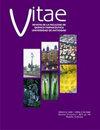ELISA法测定咖啡中赭曲霉毒素a及其与理化、微生物特性的关系
Q3 Pharmacology, Toxicology and Pharmaceutics
引用次数: 1
摘要
背景:咖啡是世界上消费量最大的饮料之一;然而,它可能含有有毒化合物,如赭曲霉毒素A (OTA)。目的:通过应用酶联免疫吸附试验(ELISA)确定在哥伦比亚销售的用于饮料制备的不同类型咖啡中OTA的存在,并分析其与物理,物理化学和微生物特性的关系。方法:选取8份哥伦比亚市售咖啡样品,采用酶联免疫吸附法测定其OTA含量。同样,进行了微生物分析,并确定了理化性质,如水分含量,aw,总溶解固形物百分比(%TDS)和提取率(%EY)。物理特性,如自由流动密度、压实体积密度(CBD)、孔隙度、平均粒径(ASP)和颜色。采用主成分分析(PCA)和聚类分析(CA)对数据进行多变量分析,定量研究咖啡样品的物理、理化性质与OTA含量之间的关系。采用LSD检验,显著性水平为95%,Pearson相关检验。结果:所有样品均含有乙酸乙酯,但仅有2份样品的乙酸乙酯含量超过规定限值,其最大值为15.449µg/Kg,为FAO/WHO食品添加剂联合专家委员会(JECFA)规定的日容许摄入量的31.449%。根据PCA和CA,样品根据与其商业表现和工业过程相关的咖啡类型、OTA含量和ASP进行和谐分组。OTA含量与%EY、%TDS、ASP、孔隙度、CBD、水分呈显著正相关(p < 0.05)。结论:在哥伦比亚销售的咖啡显示出不同范围的OTA,其中可溶性咖啡的OTA含量高于烘焙咖啡,25%的分析咖啡不符合哥伦比亚法规规定的水平。咖啡中的OTA含量与从咖啡中提取溶质的能力有关。本文章由计算机程序翻译,如有差异,请以英文原文为准。
Determination of ochratoxin a in coffee by ELISA method and its relationship with the physical, physicochemical and microbiological properties
BACKGROUND: Coffee is one of the most consumed beverages in the world; however, it may contain toxic compounds such as ochratoxin A (OTA). OBJECTIVES: Determine the OTA’s presence in different types of coffee, intended for beverage preparation and marketed in Colombia through the application of the enzyme-linked immunosorbent assay (ELISA) and analyze its relationship with the physical, physicochemical and microbiological properties. METHODS: 8 samples of coffee commercialized in the Colombian market were selected, in which the OTA content was determined by applying the ELISA method. Likewise, a microbiological analysis was performed, and physicochemical properties were determined, such as moisture content, aw, percentage total dissolved solids (%TDS), and extraction yield (%EY). Physical properties such as free-flow densities, compacted bulk densities (CBD), porosity, average particle size (ASP), and color. The data were treated with multivariate analysis using Principal Component Analysis (PCA) and Cluster Analysis (CA) to quantitatively investigate the relationships between the coffee samples concerning their physical, physicochemical properties, and OTA content. LSD test was applied with a significance level of 95 % and Pearson correlation test. RESULTS: All the samples had OTA content, but only 2 exceeded the limits allowed by the regulations, with a maximum value of 15.449 µg/Kg, which represents 31.449 % of the tolerable daily intake according to the parameters defined by Joint FAO/WHO Expert Committee on Food Additives (JECFA). According to the PCA and CA, the samples were grouped harmonically according to the type of coffee associated with its commercial presentation and industrial process, OTA content, and ASP. OTA content was significantly and positively correlated (p < 0.05) with %EY, %TDS, ASP, porosity, CBD, and moisture. CONCLUSIONS: The coffees marketed in Colombia showed a variable range of OTA, where soluble coffees had higher OTA contents than roasted coffees, and 25 % of the coffees analyzed do not meet the levels defined by Colombian regulations. The OTA content in coffee is related to properties that define the ability to extract solutes from coffee.
求助全文
通过发布文献求助,成功后即可免费获取论文全文。
去求助
来源期刊

Vitae
PHARMACOLOGY & PHARMACY-
CiteScore
1.20
自引率
0.00%
发文量
0
审稿时长
>12 weeks
期刊介绍:
The journal VITAE is the four-monthly official publication of the School of Pharmaceutical and Food Sciences, and its mission is the diffusion of the scientific and investigative knowledge in the various fields of pharmaceutical and food research, and their related industries. The Journal VITAE is an open-access journal that publishes original and unpublished manuscripts, which are selected by the Editorial Board and then peer-reviewed. The editorial pages express the opinion of the Faculty regarding the various topics of interest. The judgments, opinions, and points of view expressed in the published articles are the responsibility of their authors.
 求助内容:
求助内容: 应助结果提醒方式:
应助结果提醒方式:


